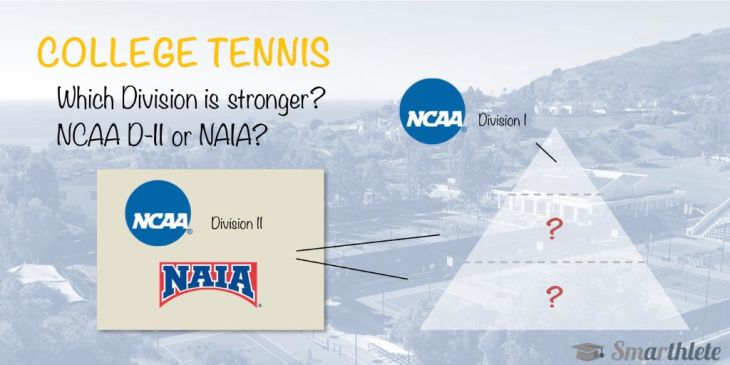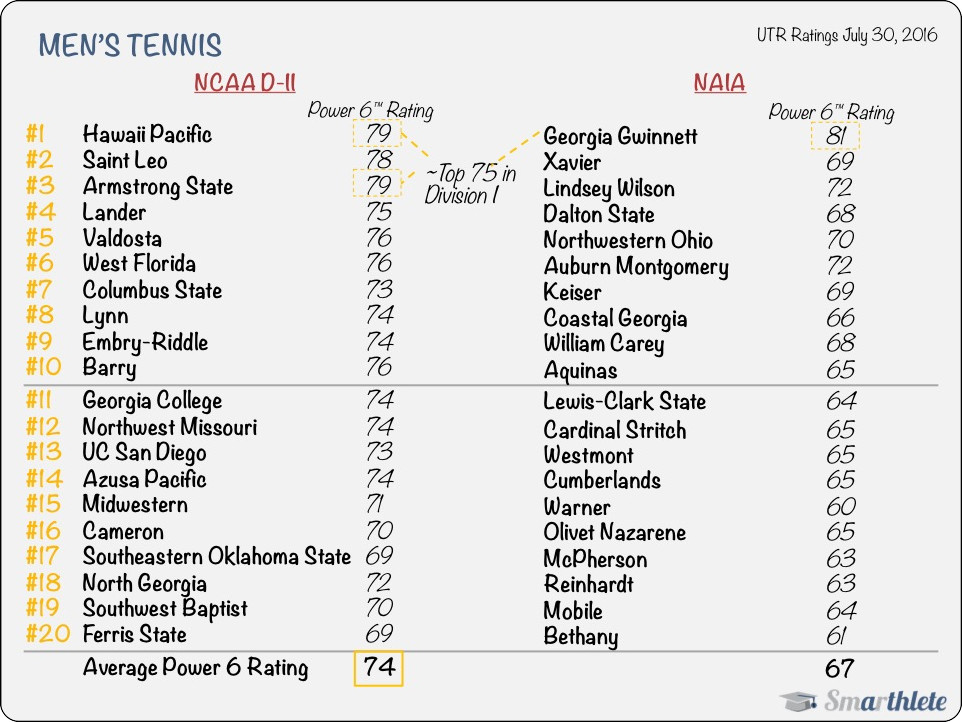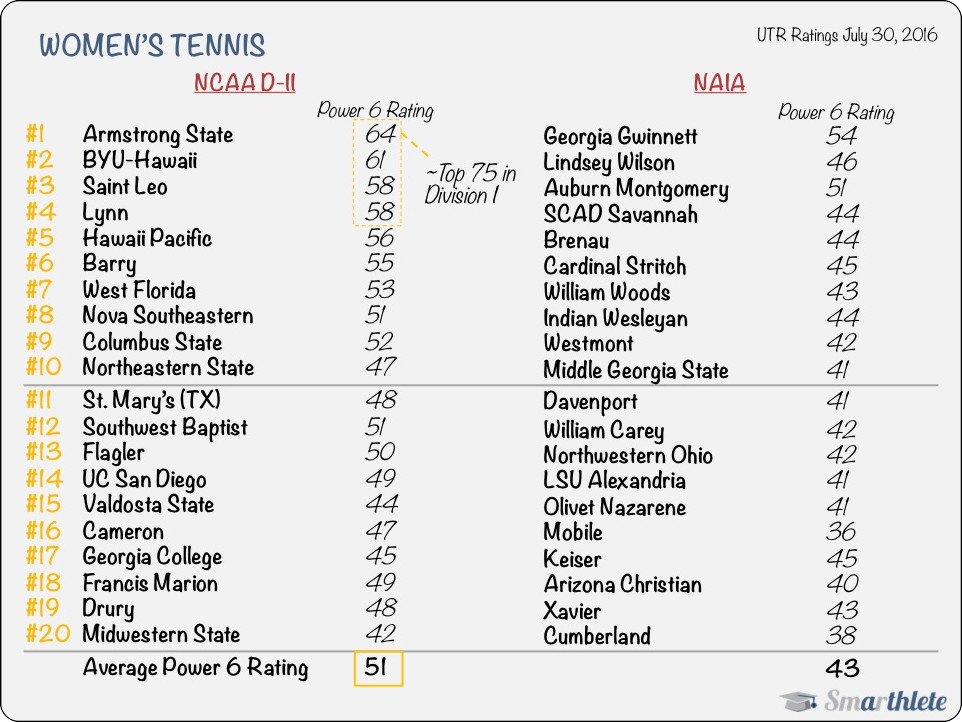Which College Tennis Division Is Better: NCAA D-II or NAIA?

It is of no surprise that future recruits dream of joining D-I schools. Those are the big names running huge athletic programs after all and few coaches would advise their players not to shoot for the stars when it comes down to kicking off their recruiting process.
Given that there are only so many scholarships in Division I, it is key for prospective student-athletes to learn more about the other tennis divisions, in which prospects can get tennis scholarships at 4-year colleges.
We will find show you today how these divisions stack up against the strongest league in 2016.
In the graphics below we list the highest-ranked 20 teams, according to the latest ranking by the ITA (NCAA D-II) and the NAIA (coaches' post-season poll). For each of these teams, we list their "UTR Power 6 Rating", which is the sum of the line-ups' six best players' Rating. With all college players being "rated" by Universal Tennis, we have an excellent basis to compare teams and divisions.
Please see the end of the article for more details about the UTR.*
College Tennis Level: NCAA D-II vs NAIA
Men's Tennis
Of all men's teams, Georgia Gwinnett is the team with the highest rating (81), taking them not only to the top of the NAIA rankings (May 2016), but also to the top of all non-D-I teams. The highest ranked teams in Division II (June 2016) are #1 Hawaii Pacific and #3 Armstrong State with a UTR of 79.
These three teams met in April with the NAIA team winning both against Armstrong State (5-4) and against Hawaii Pacific (5-3) a day later.
But despite Georgia Gwinnett's strength, the D-II teams are significantly stronger:
- The average of all twenty D-II teams is 74
- The average of all twenty NAIA teams is 67
- The second best NAIA team has a Rating of 72 - 9.0 UTR points less than the best NAIA team
Put differently, the male average Top 20 player in a D-II team has a UTR of 12.3 (UTR Power 6 Rating of 74/6) compared to the average NAIA player's UTR of 11.2 (67/6).

A difference of 7.0 UTR points (74 D-II vs 67 NAIA), respectively 1.1 UTR points (12.3 D-II vs 11.2 NAIA) is a significant one considering that matches between players within 1.0 points are in the "Competitive Zone". Matches in the competitive zone are the least predictable and result in fewer runaway (non-competitive) matches.
Where would the top teams end up compared to NCAA D-I squads? A UTR of 79 equals teams such as Alabama or Utah ranked in the range of #40 to #70 in Division I, whereas a UTR of 81 equals squads in the range of #20 (University of Arkansas) to #40 (South Carolina)!
Women's Tennis
On the women's side, we also benchmarked the Top 20 NCAA D-II (June 2016) against the Top 20 NAIA (May 2016).
The picture is pretty similar:
- The difference in the average Power 6 Rating is 8.0 points
- The average of all twenty D-II teams is 51
- The average of all twenty NAIA teams is 43
In other words, the average Top 20 female in Division II has a UTR of 8.5 (51/6) compared to a UTR of 7.2 (43/6) in the NAIA.

Although Georgia Gwinnett also tops the NAIA women's ranking, the team does not represent as big an outlier as the school's men's team. The difference to the second best NAIA team (Auburn Montgomery) is "only" 3.0 points. The NAIA top teams are not even close to the strongest NCAA D-II teams with their Ratings of 54 and 51 at the moment!
How do the above teams do compared to the elite Division I teams? The top teams in D-II have a Rating that would be on par with ranked D-I teams. Armstrong State, BYU-Hawaii, Saint Leo, and Lynn are well within the level of Top 75 teams, reflected by some wins over D-I teams by Armstrong State throughout the season.
For example, a UTR of 61 (#2 ranked BYU-Hawaii) is comparable to D-I members Syracuse (UTR 61 - ranked #27), Rice University (61 - #34), or Columbia (61 - #37). The best NAIA teams on the other hand would find themselves on par with unranked D-I teams.
Comparing the top 20 ranked men's and women's teams of the NCAA D-II and NAIA by their Universal Tennis Rating leads us to conclude that NCAA Division II is the second-best college division after NCAA Division I. Of course you will always find matchups in which stronger NAIA teams would beat weaker D-II teams, but the general level of play of the division in its entirety is better in the NCAA. How is the NAIA's level compared to the NCAA D-III? Is it a clear-cut case or could there be surprises? We will cover this question in a another blog article in the upcoming weeks!
Almost exactly a year ago, we compared the divisions for the first time. Here's the link to the article, in which we looked at the top 20 teams of the season 2015-16.
So is there anything that has changed compared to last year? The effect can't be too big, considering that the class of 2015 graduated and was replaced by new incoming freshmen, plus/minus intra-divisional transfers of athletes. What did change is that the NCAA D-II men's average score improved to 74 (from 73 last year). And the NAIA women's average Power 6 Rating improved by 2.0 points from 41 to 43!
Tennis Recruiting Implications
Based on the comparison, there are some important takeaways for prospective student-athletes:
- Don't necessarily limit yourself to D-I, D-II, or NAIA schools only!
- The levels of the teams vary massively and you could be much better off in, say, a strong NAIA team compared to a weaker D-I or a mediocre D-II team.
- Research very precisely how strong the teams are you speak with!
- Remember that there are available athletic scholarships in all three divisions!
- The governing bodies (NCAA or NAIA) have different sets of rules regarding players' eligibility!
Are you about to start your tennis recruiting process? Get started by receiving your UTR on Universal Tennis, create your free recruiting profile with us on Smarthlete, and start talking to college coaches directly through Smarthlete right away!
For those of you who don't want to miss out on our upcoming blog articles including our NAIA/NCAA Division III comparison, sign up to our newsletter on the right and you'll get it delivered straight in your inbox!
*The ITA (for NCAA D-II) and the NAIA publish their rankings of the top teams at certain points throughout the season. Universal Tennis calculates a dynamic Rating for all college players, which forms the basis for the Power 6 Rating of the various college teams. As a result of the different ranking/rating methods, a better-ranked team (by ITA and NAIA) can end up having a worse UTR than a lower-ranked team and vice versa.
For more information on the UTR please refer to the company's terminology.
NCAA is a trademark of the National Collegiate Athletic Association.